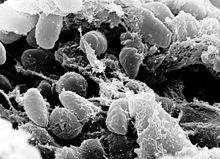Yersinia
| Yersinia | |
|---|---|

| |
| Scientific classification | |
| Domain: | Bacteria |
| Phylum: | Pseudomonadota |
| Class: | Gammaproteobacteria |
| Order: | Enterobacterales |
| Family: | Yersiniaceae |
| Genus: | Yersinia van Loghem, 1944 |
| Species | |
| |
Yersinia is a
Speculations exist as to whether or not certain Yersinia can also be spread by
Microbial physiology
An interesting feature peculiar to some of the Yersinia bacteria is the ability to not only survive, but also to actively proliferate at temperatures as low as 1–4 °C (e.g., on cut salads and other food products in a refrigerator).[4] Yersinia bacteria are relatively quickly inactivated by oxidizing agents such as hydrogen peroxide and potassium permanganate solutions.
Genetics
Database
The creation of YersiniaBase, a data and tools collection for the reporting and comparison of Yersinia species genome sequence data, was reported in January 2015.[5] The provisional representation of species addressed by the resource has been indicated in the TaxBox on this page by a superscript 'yb' beside the species name.[5] Development of YersiniaBase was funded by the University of Malaya and the Ministry of Education, Malaysia.[5]
Pathogenesis
Y. pestis is the causative agent of plague. The disease caused by Y. enterocolitica is called yersiniosis.
Yersinia may be associated with Crohn's disease, an inflammatory autoimmune condition of the gut. Iranian people with Crohn's disease were more likely to have had earlier exposure to refrigerators at home,[6] consistent with its unusual ability to thrive at low temperatures.
Yersinia is implicated as one of the causes of reactive arthritis worldwide.[7]
Also, the genus is associated with
History
Y. pestis, the first known species, was identified in 1894
References
- PMID 27620848.
- ISBN 0-8385-8529-9.
- S2CID 1528556.
- PMID 34054769.
- ^ a b c
Tan, Shi Yang; Dutta, Avirup; Jakubovics, Nick S.; et al. (16 January 2015). "YersiniaBase: a genomic resource and analysis platform for comparative analysis of Yersinia". PMID 25591325.
- PMID 19177167.
- PMID 1599522.
- ^ "EMedicine". Retrieved 2010-07-22.
- ^ Rebecca Maki from University of Pittsburghby. "Discovery of Yersinia pestis".
- ^ S2CID 9690694.
- ^ .
External links
- Yersinia Enterocolitis Mimicking Crohn's Disease in a Toddler
- Sweden: Pork warnings over new stomach illness
- Yersinia genomes and related information at PATRIC, a Bioinformatics Resource Center funded by NIAID
- YersiniaBase
